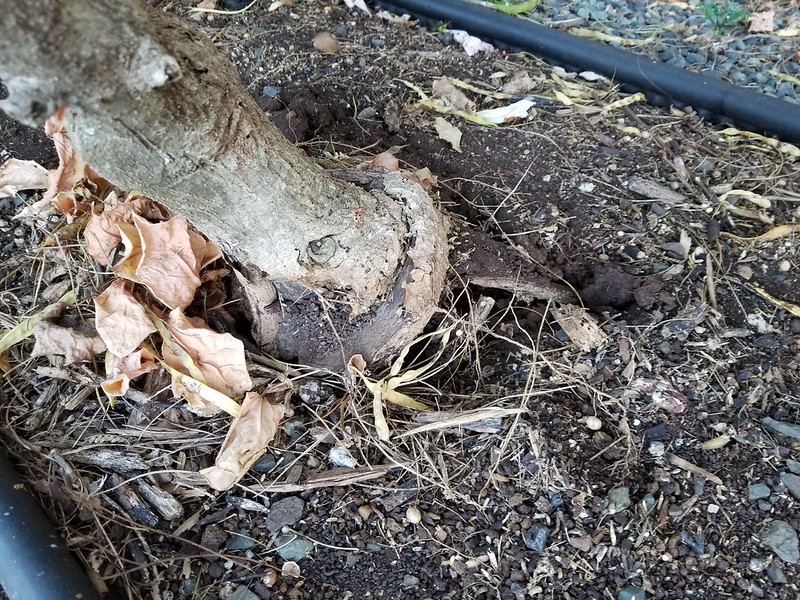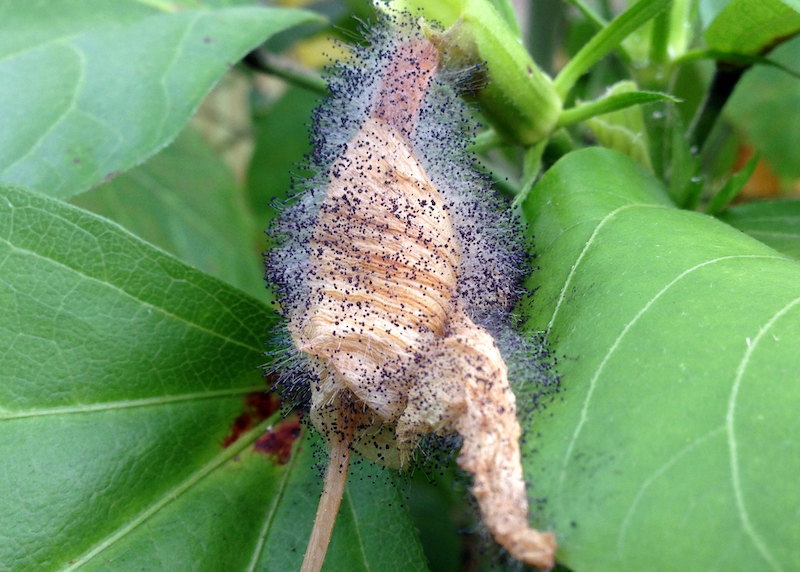Tropical and hardy varieties of Hibiscus are fairly easy to grow and not likely to be infected with diseases when they are healthy and thriving. Plants growing in their preferred growing conditions are more likely to fend off diseases and recover quickly if they are given quick and proper treatment. The proper growing conditions for all types of Hibiscus are full sun exposure, (at least 6 hours a day), moist but well-draining soil, and moderate soil nutrition. The diseases which Hibiscus may have to contend with are a short list although they cover the scope of fungal, bacterial, and viral diseases.
Armillaria Root Rot
Sometimes referred to as Mushroom Root Rot or Oak Root Rot, Armillaria is a fungus that affects the roots of a wide variety of plants, particularly woody types such as shrubs and trees. The fungus lives in the soil and is more common in newly cleared sites, such as housing developments. Rose of Sharon, Hibiscus syriacus, is more likely to be affected than the herbaceous perennial types of Hibiscus.
Identifying Armillaria Root Rot
Hibiscus infected with Armillaria root rot will produce fewer and smaller leaves and flowers. As the foliage dies and falls, the branches will start showing signs of dying back until eventually, the whole plant is dead. This process can take many years depending on the size of the plant. Other signs of the Armillaria fungus are the growth of honey-yellow mushrooms near the base of the affected plant and dark, black lines in the wood at the base of the tree or shrub. In the late stages of the disease, there will also be black, shoelace-like strings of the fungus growing just under the soil that may be hard to distinguish from the rotten roots.

Photo by Scot Nelson
Treating Armillaria Root Rot
Mechanical and cultural methods are the only way to treat Armillaria root rot. No chemical formulation exists for the home gardener to use. Remove diseased plants as quickly as possible and do not plant any plant that is susceptible to the fungus back into that part of the garden. Careful watering of woody plants helps to reduce the risks of the fungus attacking. Avoid soaking woody trunks of trees with spray-type sprinklers. Drip irrigation or soaker hoses keep the bark dry and direct water toward the root system. It is possible to save prized plants that are not heavily infected. In the spring, remove some of the diseased outer bark and a large amount of the infected soil around the root zone. Allow the HIbiscus and the soil to dry out during the summer. Avoid overhead watering and add fresh, clean soil back to the root zone at the end of the summer.
Bacterial Leaf Spot
Sometimes bacterial leaf spot is referred to as bacterial blight and it can affect a wide range of ornamental and edible plants. Generally only leaves and stems are affected, although if left untreated, the blight will spread to the flowers on Hibiscus shrubs. The bacteria Pseudomonas spp exists naturally in many climates and on a wide variety of plants. During periods of cold temperatures and high moisture, the bacteria will infect plants that may be stressed from harsh winter temperatures or poor growing conditions. The spring and late fall are when conditions tend to be optimal for the Pseudomonas bacteria.The infection interrupts normal leaf growth in the spring, causing whole portions of the plant to die back. Eventually, death of the whole plant occurs.
Identifying Bacterial Leaf Spot
Infected leaves will turn yellow and possibly have dark spots across both sides. The foliage also will become distorted and fall off the plant as it dies. Stems can also be affected and will develop growths called cankers, which over time will restrict the proper movement of nutrients in the woody portions of the Hibiscus. Flowers buds may also be infected, causing premature flower drop before opening.

Photo by Scot Nelson
Treating Bacterial Leaf Spot
Choosing cultivars or varieties of Hibiscus that are resistant to this blight is a great way to keep the disease out of your garden. Quickly diagnosing bacterial leaf spot also ensures that the Hibiscus shrubs will be saved. Prune out infected foliage, flower buds, or branches and dispose of them in the trash or burn them if it is allowed in your community. Good garden hygiene throughout the year is critical to keep the bacteria from spreading year after year. Clean up spent foliage and flowers at the end of the growing season before the weather becomes cold and wet. Avoid overhead watering of Hibiscus, which will spread any bacteria present to other susceptible plants. Watering the root zone with drip irrigation or a soaker hose is much more efficient and not likely to get the foliage wet.
Botrytis
Botrytis is more commonly called gray mold and is very common during periods of cold and wet temperatures, such as early spring or late fall. Container-grown tropical Hibiscus often will show signs of Botrytis when they are put outside too early in the spring or when they are grown too close together and overwatered, such as in a display in a nursery or on a patio or deck. Botrytis will infect plants most often after they have sustained some type of physical injury, such as branch breakage or damaged flower buds from being tightly packed during shipping from the grower.
Gray mold will quickly spread to other parts of the plant once the white, gray, or black colored spores begin to form at the initial site of the infection. Botrytis does not affect woody plant structures and is only found on green material or the buds and flowers of Hibiscus. New leaf shoots and flower buds may fail to open properly or fall off the plant.
Identifying Botrytis
Botrytis starts out as a spot that appears water soaked and translucent on a leaf or flower. Eventually, the infected part will turn brown, then black, and then die completely. After a period of high humidity, spores will grow on the dead plant material and are easily transmitted to other parts of the plant or plants in the immediate area through overhead watering or pruning tools that are not properly disinfected between tasks.

Photo by Scot Nelson
Treating Botrytis
Providing the right growing location with proper soil drainage and full sun exposure is the best way to prevent outbreaks of Botrytis. Proper air circulation around plants growing in containers or in the garden is critical to keep infection down. Prune out any damaged branches or flowers as soon as possible, especially during humid periods. Keep Hibiscus evenly watered while keeping the foliage as dry as possible. Clean up any spent flowers or foliage as they drop during the season. Few fungicides are effective in damp conditions when the mold is active and will only protect uninfested parts of the Hibiscus.
Hibiscus Chlorotic Ringspot
Viruses in plants are transmitted either through an insect vector such as some type of sapsucker or by infected tools used when grafting parts of plants together or taking cuttings for propagation. Hibiscus chlorotic ringspot is most often transmitted during the propagation of infected plants and is not treatable by chemical means. The virus will live in a plant for the rest of its life, generally only causing cosmetic damage without affecting flowering or overall growth.
Identifying Hibiscus Chlorotic Ringspot
Signs of chlorotic ringspot include mottled yellow or a circular yellow spot on foliage. Plants that are infected and growing in mild and temperate climates (Florida, for example) may never show symptoms. Often the disease is spread through the propagation of asymptomatic plants.
Treating Hibiscus Chlorotic Ringspot
The only way to control Hibiscus chlorotic rIngspot is by cultural means and good sanitation practices. Sterilize any pruning or cutting tools before and after taking cuttings of any plant, even if they appear healthy. Purchase plants that have been declared virus-free and do not show any signs of yellowing leaves. Continue to grow infected plants as long as they still appear to thrive. Dispose of the plant completely when growth declines or the plant becomes affected by any secondary pest or disease. Do not compost plants with viruses. Composting does not kill the viruses and makes them likely to be spread around the garden.
Hibiscus Disease Chart
|
Disease |
Identifying |
Treating |
|
Armillaria Root Rot |
Vigorous growth declines over time, black streak in the woody portions of the shrub, especially at the base. |
Removal of infected plant material or the whole plant |
|
Bacterial Leaf Spot |
Disfigured leaves that are yellowing and have dark spots on the top and bottom |
Remove infected parts of the plant and dispose of them in the trash |
|
Botrytis |
Flowers, buds, and leaves that appear water soaked or covered in a fuzzy gray and black mold |
Remove infested plant parts and dispose of them in the trash |
|
Hibiscus Chlorotic Ringspot |
Stippled or mottled leaves, unusual color streaking of the flowers |
Prune out affected parts, choose plants that are rated as virus resistant |
Sources: "Hibiscus—Hibiscus spp." Agriculture and Natural Resources, University of California. ipm.ucanr.edu
 |
Author Robbin Small - Published 5-12-2023 |
